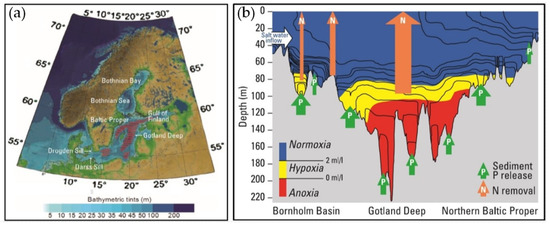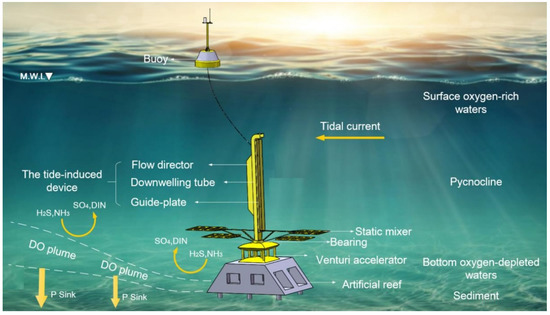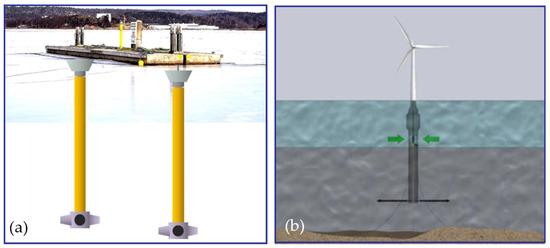A technology that uses artificial methods to make sea water flow from top to bottom. The upper oxygen-rich water can be sent to the bottom hypoxic zone to alleviate marine environmental problems.
- Artificial downwelling
- Hypoxia
- Environmental impact
xNote:All the information in this draft can be edited by authors. And the entry will be online only after authors edit and submit it.
1. Introduction
Due to global warming and coastal eutrophication, the coastal waters that are usually associated closely with intensive human activities are facing hypoxia, or low dissolved oxygen concentrations, representing a significant threat to the health and economy of coastal ecosystems [1][2][3][4][1,2,3,4]. Individuals of immobile species, such as oysters, mussels, and sea cucumber, have no capacity for escaping low-oxygen areas and are especially vulnerable to hypoxia [5][6][7][5,6,7]. These organisms can become stressed and may die in low-oxygen conditions. Fish deaths can also result from hypoxia, especially when the concentration of dissolved oxygen drops rapidly, resulting in significant impacts on marine food webs and the economy [8]. Hypoxia is hazardous for benthic habitats; it alters the nutrient cycling, reduces the biodiversity of marine communities, and often leads to the blooming of harmful blue-green algae [2][9][2,9].
The dynamics of coastal hypoxia is rather complex [10][11][10,11]. Although coastal hypoxia can be caused by natural processes, such as stratification and hydromorphology [2][12][13][2,12,13], the dramatic increase in the number of world coastal waters developing hypoxia is linked to anthropogenic factors, such as eutrophication and global climate change resulting from human activities [14]. More than 400 persistently or seasonally hypoxic regions have been reported in the coastal waters of the world [15], covering an area of 245,000 km2 [3] [3]. It is reported nowadays that major fishery areas—the Baltic, Kattegat, North Adriatic, Black Sea, Gulf of Mexico, and the East China Sea—are suffering ecological degradation and loss of biomass as a result of coastal hypoxia [3][7][16][17][3,7,16,17].
While nutrient load reduction plays a fundamental role in environmental management for coastal hypoxia [2][18][2,18], eutrophication management faced recalcitrant challenges with little success over the past 30 years; the problem of eutrophication is still unclear in terms of the physical environment [19], ecosystem characteristics, nutrient sources, socio-economic driving forces, and governance measures. Hypoxia in marine ecology urgently needs to be alleviated, especially in the field of marine fisheries [20].
Artificial downwelling systems, which is one of the geo-engineering-based adaptation options, are recognized as an important support for these plans and for the subsequent mitigating hypoxia in coastal waters [21]. Artificial downwelling, as an engineering solution to coastal hypoxia, powered by green energy, such as solar, wind, wave, or tidal energy, can develop a compensatory downward flow on a kilometer scale, favoring below-pycnocline ventilation and thus mitigating hypoxia in bottom water. This may be the most realistic alternative for mitigating hypoxia in coastal waters in the future [22].
Artificial downwelling transports oxygen-rich surface waters into oxygen-deficient deeper layers [23], strengthen the below-pycnocline ventilation, increase the dissolved oxygen concentration in the bottom waters, and consequently mitigate bottom hypoxia. Most studies to date yielded positive results with respect to artificial ocean downwelling: (1) Well-designed artificial downwelling systems maintained stratification and did not significantly increase bottom water temperature; therefore, in stratified oceans, the thermocline remained stable and the process preserved a cold-seawater fishery habitat for acrobenthic communities [24]; (2) levels of dissolved oxygen concentration (DO) were usually elevated in bottom waters [25]; and (3) concentrations of iron, methane, phosphorus, nitrogen, and hydrogen sulfide were shown to decrease in bottom waters and sediments [26].
Therefore, techniques for artificial downwelling are being researched, with many new devices and equipment in development. Recently, institutions and scientists dedicated great efforts to the research of artificial downwelling, with great progress being made and techniques addressing such issues including density current generators, wind-powered pumps, wave-powered pumps, and current-induced artificial downwelling. The aim of this paper is to review available technologies to pump oxygen-rich surface waters into oxygen-deficient bottom waters to mitigate hypoxia in coastal waters, and to suggest procedures for future research. We also assessed the potential benefits and risks associated with these artificial downwelling technologies.
2. Artificial Downwelling Technologies
2.1. Density Current Generator (DCG)
A prototype device of ocean artificial downwelling named a density current generator (DCG), i.e., an electrical pump powered by solar energy and fossil fuel, was proposed by the University of Tokyo and was developed and moored in the Hazama Inlet of Gokasyo Bay, Japan [27][28][32,33], where the red tide was insignificant since the installation of the apparatus in 1997 [29][27].
The DCG system, which was designed with a steel riser pipe and an electrical pump of great power, mixes surface and bottom waters with density control [29][27].
The mixture then discharges to a neutral-buoyancy depth via the ring-nozzle by the motor-driven impeller installed in the pump casing. The discharged water is quickly mixed with the middle layer, which has a significant entrainment rate of 10 times [30][34]. The flow rate of 120,000 m3/day, generated by electric power of only 12 kW, with the aim of improving water quality in Gokasho Bay, Japan has a good effect during actual operation [31]. The system operated successfully for more than 12 years, and long-term observations confirmed the positive effects of the DCG in increasing the abundance and biomass of benthos and reducing the volume of hypoxic bottom water. However, the low energy consumption efficiency and the high construction and maintenance expenses of the system make it uneconomic for large-scale or sustainable applications [32][35].
2.2. Wind-Powered Pump
In the Baltic Sea, there are 6000 square kilometers of continually expanding hypoxic zone, which is now about four times the area observed in 1960 [33][36], making the Baltic Sea one of the most serious regions of hypoxia [34][37]. Studies have shown that, in addition to climate warming, loads of continental nutrients have caused an increase of eutrophication in the last 50–100 years [35][38], which is the key to the increasing severity of hypoxia [36][39]. This lack of oxygen in the Baltic Sea caused huge ecological damage and economic losses [37][40].
Stigebrandt and Gustafsson carried out an ecological project called BOX [21] [21] (Baltic deep-water Oxygenation) in By Fjord on the western coast of Sweden, where a strong permanent halocline and serious hypoxia problem exists (as shown in Figure 1) [38][28]. This project designed 100 offshore-wind- powered pump to bring oxygen-enriched water from 50 m to 125 m [39][41], with each pump providing 0.6 kW of power and pumping 100 kg of water to the lower layer every second [40][42]. The calculation is aimed at the Baltic Sea; hence, it needs to be recalculated for other conditions according to the method provided by Ander et al. Stigebrandt et al. employed the wind-pump system for two and a half years, showing it to be significantly effective [40][41][42,43].

Figure 1. (a) Map of the Baltic Sea. (b) Vertical distribution of hypoxia in the Baltic Sea [33][36].
Figure 2 shows the wind-pump system, with the wind turbine generating electricity on the working platform and delivering power to two pumping systems that connect to the upper end of the downwelling pipes; the lower end of the pipes is fixed to the seabed by an anchor chain. The water inlet is set at 2 m below the sea surface, and the water outlet is set at 6 m above the seabed. Surface water is drawn into the downwelling pipe and pumped down. The discharged surface water is mixed and entrained with submarine water then rises to neutral buoyancy in the hypoxia zone and spread horizontally.
2.3. Wave-Powered Pump
The concept of wave utilization to pump well-oxygenated surface water was proposed for the Baltic Sea and the North Adriatic Sea [42][43][29,44]. Christopher Carstens first proposed a wave-energized aeration pump for the Baltic Sea hypoxia problem (WEBAP) in 2008. The physical principle of the WEBAP is that a floating breakwater should collect incoming waves into a reservoir inside the breaker. The waves hit and run up the slope of the floating breakwater until an overtopping event occurs. This process yields the potential energy in the reservoir, which in turn forces surface water into the desired depth around the halocline [44][45]. Through linear wave theory and energy analysis, Carstens investigated and calculated the mean and median energy flux of the Baltic Sea wave power, concluding that, combined with the amount of power needed to oxygenize the Baltic Sea estimate by Anders Srigebrandt et al. [21], the efficiency of the breakwater (as shown in Figure 3) to solve the problem of anoxia was evaluated [38][28]. This project is expected to cost 16 million euros.
Antonini et al. proposed a concept for a wave-driven device in 2012, named OXYFLUX in 2015, for artificial downwelling and suggested the possibility of downwelling surface seawater by using wave energy to solve the problem of eutrophication and hypoxia in the North Adriatic Sea [45][46]. Wave energy is used to invert the density structure of the ocean and force oxygen-rich surface water into the oxygen-depleted bottom layers [46][47].
The OXYFLUX consists of a truncated-conical floater, a downwelling pipe, and a stabilizing ring [45][46]. The buoyancy of the whole structure is entrusted to a truncated-conical floater, which keeps the structure afloat as well as collects water from overtopping [47][48]. The connection with the bottom, where a stabilizing ring is mounted, is fastened by means of a rigid pipe. Kofoed (2002) identified the optimal slope angle to maximize the overtopping discharge for a linear structure ramp as 30°. For the OXYFLUX, the floater ramp slope was designed to be 25.3° to maximize the overtopping discharge according to the buoyancy needs. The material of the floater has been selected based on the need to guarantee an appropriate level of the free-board crest. The physical principle of the OXYFLUX is very simple. The floater collects incoming waves into a reservoir floating on the sea. Water overtopping yields a higher hydraulic head in the reservoir that can be used to overcome the density difference between the surface and deep water. As a result, oxygen-rich surface water is induced downward through the downwelling pipe. At the bottom of the device, there is a stabilizing ring that has the function of reducing the heave motion by means of the induced viscous dissipation and accordingly facilitates the overtopping.
2.4. Current-Induced Artificial Downwelling
In 2019, Xiao et al. proposed using the kinetic energy of the surface current to invert the density structure of the ocean and pump oxygen-rich surface water into the bottom oxygen-depleted layers by means of a current-induced pump [48][30]. The Changjiang Estuary, China, is one of the largest areas to suffer seasonal hypoxia in the world [12][49][12,49], however, semidiurnal tidal current exists widely throughout the Changjiang Estuary and its adjacent areas, with data from the tide observatory indicating that in the spring tides, the tide may reach a speed of 1–1.6 m/s [50].
The possible tidal pump proposed for this type of artificial downwelling device could have a 90° bend, a vertical downwelling pipe, and a floating platform [48][30]. On the back of the upper bend is a flow director keeping the pump consistently toward the incident flow direction, with deviations from this direction causing the pump to be unbalanced subject to the moment of horizontal flow, which is an advantage in bidirectional flow, e.g., tidal power applications. A ballast hanging on the lower end of the pump keeps the downwelling pipe erect as much as possible. When passing over the upper bend inlet of the pump, the horizontal current decelerates due to the blocking effect. According to the Bernoulli principle, this deceleration increases static pressure at the entrance which, if large enough to overcome stratification, drives downwelling flow in the pump. If the tidal current is strong enough to overcome stratification, downwelling flow is produced, evolving into an oxygen-rich buoyant plume below the pycnocline, which offers in situ conditions to experimentally study the related ecological effects of artificial downwelling. Mathematical and hydraulic modeling analyses indicated that a tidal-driven pump for artificial downwelling drives downward flow in the pump at a flow rate ranging from 0.4 to 1.1 m3/s, with a relative density difference between the diluted surface water and the bottom water ranging from 0.004 to 0.008 and a horizontal current reaching its peak at 1.6 m/s.
Fan et al. proposed an improved current-induced pump for artificial downwelling in 2019, which is low-cost, reliable, and easy-to-use for Muping marine ranching, located in Shandong province, China, as shown in Figure 4a,b [51]. Marine ranching plays a significant role in the development of the coastal marine ecology and economy [17]. However, the large-scale death of benthic organisms caused by hypoxic bottom waters results in huge economic losses to marine ranching [52]. Figure 4c shows the time series of the observed dissolved oxygen concentrations of marine ranching in three depths in the summer of 2016. Before 27 August, the bottom water appeared hypoxic, causing hundreds of millions of CNY (Chinese yuan) loss. In order to reduce the loss caused by hypoxia, Fan et al. (2019) further optimized the structure of the tube based on the theories of Xiao et al. (2018) by adding the concrete base and mixer, thus enhancing the efficiency of the downwelling device and its applicability in marine ranching.
Fan et al. studied the performance of the device, indicating that with a cross-sectional tube area of only 0.12 m2, a flow rate of 200 m3/h flow rate downwelling was induced when the speed was 0.4 m/s and the density difference was 0.5 kg/m3 [54] [53]. Therefore, the problem of hypoxia could be greatly improved if this device is deployed widely in Muping.
The conceptual diagram of this device in the sea is shown in Figure 5. Its main feature is a vertical square tube with a 90° curved head, and the bottom of the square tube is installed on an artificial reef to fix it to the seabed. There are also static mixers installed on both sides of the device, allowing surface water to flow out from the bottom of the pipe and pass through two wing-like guide plates to fully mix with the surrounding water so that it can diffuse in the hypoxic area. The downwelling flow rate generated by this device is proportional to the equivalent diameter and bending radius of the tube and is inversely related to the length of the tube. Compared to round tubes, square tubes exhibit a larger flow cross-section with the same diameter.

Figure 5. Sketch of the improved tide-induced device for marine ranching [53][54].
3. Discussion and Conclusions
In general, the techniques about artificial downwelling for mitigating hypoxia in coastal waters are appropriate and suitable for certain applications. They own unique advantages and drawbacks. This paper has set out the results of the literature review and case study analyses. The purpose and research themes of artificial downwelling, their design, highlighted issues, monitoring, management, and performance have been examined.
The DCG was greatly successful in the ecological restoration of a semi-enclosed bay. It was supported strongly by the Japanese government and the local fisherman cooperative organizations, so the technology matured in regard to operation practice for the last ten years. However, there are also some drawbacks, including (1) it is not cost-effective in practice; (2) the working range of the DCG system is limited by the topography, therefore, if it is applied in enclosed and semi-enclosed water body, the DCG system will get very good effects; (3) The complex mechanical and electrical system and its active control system is needed as the reliability and safety is a big problem in the ocean [55][79]; (4) the long pipe may be twisted or broken.
A wind-powered artificial downwelling system is probably the most efficient and mature way to mitigate hypoxia in the Baltic Sea. There is enough wind energy to provide unlimited operation time without consideration of power limitation. However, the huge up-front investment and long-term operation and maintenance costs, which will reach 200 million Euros budget, bring a heavy burden to the government and society, and so on [21].
Wave energy conversion is quite feasible for artificial downwelling’s power supply. OXYFLUX is quite a novel way to power artificial downwelling. It was developed for North Adriatic summer conditions (i.e., really small waves), which is reliably and predictably available at all hours. [56][80]. On the other hand, it is necessary to optimize the system structure to improve reliability and efficiency. In this way, the system can access enough density difference head to pump the surface oxygen-rich seawater into the bottom water. The advantage of adopting OXYFLUX is that a complicated structure is unnecessary for the realization of downwelling based on this principle. OXYFLUX is able to work with really small wave heights and pump water with breeze waves (around 0.3–0.5 m wave height). It is worth mentioning that oxygen depletion in the world’s coastal waters primarily caused by density stratification in a body of water. The density stratification will be destroyed and the hypoxia will be mitigated under the combined action of winds and waves.
According to the research of Fan et al. [57][81], the main question of tubular artificial upwelling is the energy flux balance, which is integrated across the downwelling pipe to assess the effects of head difference, water flow rate, friction loss power in the pipe, and power demand of the water column motion.
Current-induced artificial downwelling system can unlimitedly access to marine energy. On the other hand, compared with the DCG and BOX engineering downwelling devices, the tide-induced downwelling device is simple in structure, convenient in processing, low in cost, and easy to implement, and has the potential to be widely deployed and applied in marine ranching. The tide-induced device for artificial downwelling. Compared with other devices, the simplicity, lack of moving mechanical parts, cheap cost, and reliability are the important advantages that make the tide-induced device useful for applications where semidiurnal tidal current widely exists [58][82]. However, the limitation is that tidal power is not available globally. Furthermore, the current-induced artificial downwelling technology is strongly limited in the duration of tide and the water flow rate. If such a current-induced artificial downwelling system could be viable for a hypoxia area or marine ranching, a large number of devices would be necessary [59][83].
Integrated multidisciplinary approaches should be used for the application of artificial downwelling technology and research of its ecological effect. D. Gilbert et al. pointed out the importance of monitoring in the hypoxic area, the effectiveness, and ecological impact, and perhaps potential side effects of downwelling require comprehensive environmental monitoring and analysis of biochemical geophysics [60][84].
As discussed, the artificial downwelling technologies are the most promising choice as a geoengineering method for mitigating hypoxia in coastal waters. It is a clean, physical process of artificial mixing with no added substances and has a brighter future and more applications.



